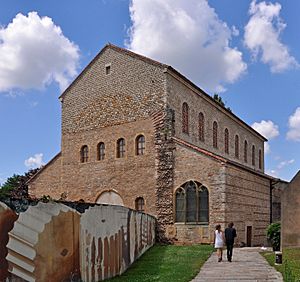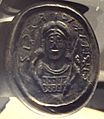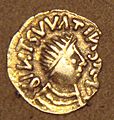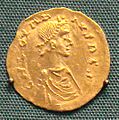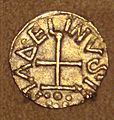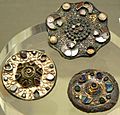Merovingian dynasty facts for kids
The Merovingians were a powerful family of Frankish kings. They ruled a large area that is now mostly France. Their rule lasted for about 300 years, from the 5th century to the 8th century.
People at the time sometimes called them the "long-haired kings." This was because their hair was never cut. Long hair was a symbol of power for Frankish leaders. Warriors, on the other hand, usually kept their hair short. The name "Merovingian" comes from an old Germanic word, similar to "Merewīowing" in Old English.
Who were the Merovingians?
The Merovingian family got its name from a leader called Merovech. He was a semi-legendary figure who led the Salian Franks from around 447 to 457. He was an important early leader for the Franks.
How did Clovis I unite the Franks?
One of the most famous Merovingian kings was Clovis I. He became king around 481. Clovis was very skilled at warfare and leadership. Around 486, he defeated Syagrius, who was a Roman ruler in Gaul. This victory helped Clovis take control of most of Gaul north of the Loire River. He brought many different Frankish groups together under his rule. This made the Merovingian kingdom much stronger and larger.
Images for kids
-
A signet ring that belonged to Childeric I. It is now in the Monnaie de Paris museum.
-
A Frankish gold coin called a Tremissis. It was made in the mid-6th century and looked like coins from the Byzantine Empire.
-
A coin featuring Chlothar II, who ruled from 584 to 628. This coin is in the British Museum.
-
A gold coin called a Triens from Dagobert I's time. It was made by a moneyer named Romanos between 629 and 639.
-
Another Frankish gold Tremissis with a Christian cross. It was made by a minter named Madelinus in Dorestad, Netherlands, in the mid-7th century.
-
Merovingian brooches, which were used to fasten clothes. These are in the Cabinet des Médailles.
-
A beautiful gold chalice from the Treasure of Gourdon.
-
The cover of a Merovingian sarcophagus (a stone coffin). It has a Christian symbol on it and is in the Musée de Saint-Germain-en-Laye.
See also
- Franks (main history of Frankish kingdoms)
 In Spanish: Dinastía merovingia para niños
In Spanish: Dinastía merovingia para niños


